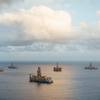The strong and sustained rebound in the price per barrel of oil, coupled with the economic recovery in Asia has offshore production related companies planning for a big 2000. Following is a synopsis of a report generated by Washington, D.C.-based International Maritime Associates Inc. which assesses the market outlook for FPSO vessels, production semis, TLPs and spars.
There are currently 107 floating production systems in operation worldwide, which is an increase of nearly 67 percent over the inventory reported in International Maritime Associates' report dated September 1996. In real terms, the increase means the addition of 49 units, broken down as such: 3 TLPs, 2 mini TLPs, 33 FPSO vessels, 9 production semis and 2 production spars.
Another 54 floating storage vessels (without production capability) are currently in operation. This figure includes nine units delivered since September 1996, two of which are used for LPG storage. Orders are currently in hand for 21 floating production and five storage systems. This total is two fewer production units and one less storage unit than reported in the March 1999 update, reflecting the slowdown in offshore activity over the past 18 months. Delivery of the units now on order will increase the inventory of floating production systems by 20 percent.
International Maritime Associates has identified 209 floating production systems currently being planned are under study. These are known projects where a floating system is being considered as the production solution. some of these are in the advanced design stage — some are at an early stage of consideration. Proceeding with individual project will hinge on the economics of the discovery, which in turn will be influenced by the expected price of oil and project development cost. not all will materialize, and in some cases, another production solution will be selected. And there are undoubtedly other projects in the planning and study phase where information has not yet been publicly released.
The current list of projects being planned or under study is a substantial increase over the 188 projects identified in the March 1999 report, which seems to indicate that interest in projects involving floating production continues to be strong, despite the downturn in actual orders over the past several months. The Gulf of Mexico again heads the list with 52 projects, the biggest increase in planned projects since the March 1999 report. West Africa is second to the Gulf of Mexico with 46 floating production projects planned or under study. The North Sea is third with 41 projects, followed by Southeast Asia, Brazil and Australia. (See Chart 3)
Investment In 2000 and Beyond
The price per barrel of oil has steadily marched upward since earlier this year, driven primarily by the recovering economies in Asia and the output quotes enacted and strictly adhered to by OPEC nations. As the price of oil stabilizes, investment budgets for exploration and development should proceed upward as well. According to International Maritime Associates, recent developments are beginning to positively impact E&D. For example, it notes that:
• Conoco will increase capital spending in 2000 to about $2.4 billion from $1.8 billion in 1999, contingent upon a $17 to $18 price per barrel. Drilling activity has increased at Conoco in recent months, and several rigs are undergoing or planned for re-activation.
• Salomon Smith Barney, in its mid-year report, said a record number of survey respondents plan to increase E&P expenditures in 2000. According to the survey, 73 percent of the participants said they plan to increase capital spending next year, and 65 percent said they expect E&P in 2000 to increase more than 10 percent.
• According to Offshore Data Service, the number of rigs working on turnkey wells in the Gulf of Mexico has risen to levels not seen for more than a year.
• Global Marine reports that day rates for offshore rigs increased 1.5 percent in July over the preceding month, following a steady decline during the preceding 14 months. Semisubmersible rates increased 2.6 percent; jack-ups .3 percent.
In addition, the market value of oil service company stocks are clearly back in favor as well. Major drilling companies have seen their stock price increase 75 to 175 percent since March, and analysts have been upgrading many of the companies. Another indicator of the more positive mood in the sector in the increase in inquiries to construction companies to resurrect and update proposals on offshore projects that have lain dormant for 12 to 18 months.
While the prediction of the course of oil pricing is part art, part science, there are currently no indicators, which would suggest a downturn by the end of the year, beginning of 2000. The principal threat in the short term is an unraveling of the producer's cutback agreement, which is considered unlikely given all of the pain endured worldwide during the previous 18-months' downturn. International Maritime Associates sees the cutbacks staying in place — if not relaxed a bit — but not abandoned before March of 2000. Other potential threats include an unraveling of the world economy from some economic shock, such as a major devaluation of the Chinese Yuan; military confrontation between China and Taiwan; or a total collapse in Russia that draws in its neighbors.
Longer term, there remains a threat that production capacity in low cost fields could be significantly increased, particularly if upstream activity in the Middle East is opened to the oil majors. Increased land-based production — particularly given its much lower production costs — continue to be a threat to the future of offshore production, but evolving technologies which continue to lower the cost of offshore production make the investment attractive. In fact, many offshore projects can be brought on stream for a cost that would be financially viable at $15 per barrel, and with technology continually driving down production costs, lower breakeven points are likely in the future. According to SBM, a number of oil fields can be developed economically with oil prices as low as $10 per barrel, and Elf's Girassol development is expected to break even at $9 to $10 per barrel.
The preceding is excerpted from International Maritime Associates' regular report on Floating Production Systems. For information on obtaining a full text version contact: International Maritime Associates, James R. McCaul, 600 New Hampshire Ave., N.W., Suite 140, Washington, DC 20037; tel: 202-333-8501; fax: 253-681-7453; e-mail: [email protected]
Sponsored Content
Experience Custom Yacht Signs and Designs Tailored to Perfection!

April 2025
 Read the Magazine
Read the Magazine

 Read the Magazine
Read the Magazine
This issue sponsored by:

Massa Products Corporation: Innovating Sonar Technology & Securing the Future of the Maritime Workforce
Subscribe for
Maritime Reporter E-News
Maritime Reporter E-News is the maritime industry's largest circulation and most authoritative ENews Service, delivered to your Email five times per week








